

Matt Mills: Image recognition that triggers augmented reality. Netgened2011 - Augmented Reality. Augmented Reality in the Classroom. Dan McWilliam - Grade 7 Humanities Augmented Reality is the digital layering of information overtop of, or in front of, the real world. This content is viewable through a digital device that places it realtime over the real world through the camera. Imagine a pair of eye glasses that could show the Facebook status or most recent Twitter above a person’s head. Augmented Reality browsers are working to make this possible. Some advances have been made in this with browsers such as Wikitude, Layar, Junaio, Acrossair and others. Our students have been given iPads this year and the addition of Augmented Reality options for their work has helped their engagement with the new tool.
AurasmaAurasma, is a very intuitive application that allows users to choose their target image and the digital content that will activate when the target is seen by the camera. SciMorph: Science and Learning » activities. Explain Everything ™ Integration of AR. Meaningful Integration of Augmented Reality in Education Below you will find a list of ideas and apps to help meaningfully integrate augmented reality into education.
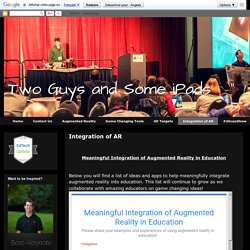
This list will continue to grow as we collaborate with amazing educators on game changing ideas! Homework Mini-Lessons: Grade Level: All grades We use Explain Everything for many activities in our classrooms. Grade Level: PK-2, ELL. Rubric - Augmented, Digital Story - jrobinsonproject. Creating Augmented Reality Applications in History Classrooms: An Example Class Activity. In education, we are always looking for different ways to contextualize the material to keep our students engaged.

Technology affords many opportunities to do so; in this blog post I will be discussing how to create an augmented reality by using digital media. Augmented Reality (AR) refers to digital materials such as photos, documents, and videos that are displayed by mobile devices based on cues from the external environment. These digital materials serve as a means to augment the user experience. How it works: The mobile device recognizes external cues from the learning environment and delivers the relevant instructional content. External cues include objects and locations that are shared characteristics between the educational material and learning environment. As an example, history textbooks may include a QR code that can be scanned by students with their mobile device.
. · What is the name of the historical artifact? · What is the use of the historical artifact? Acknowledgements. Bringing Augmented Reality to the Classroom. Although it is still in the early stages of development, the gradual growth of accessible apps like Aurasma are starting to make augmented reality in the classroom seem like it might soon become…well, a reality!
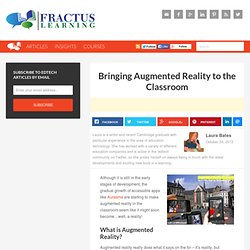
What is Augmented Reality? Augmented reality really does what it says on the tin – it’s reality, but improved! It provides a unique way of adding a digital overlay to the real world around us, enabling users to interact with their real-world environment in new and enhanced ways using technology. Handheld devices like tablets and smart phones allow users to view their immediate surroundings using video and photographs. Thedigitalshift - Augmented Reality In The Classroom. Augmented Realtiy Developer. Augmented Reality Brings New Dimensions to Learning. Editor's Note: Drew Minock, who co-wrote this piece, is an elementary teacher, co-founder of the popular education blog Two Guys and Some IPads, and is one of the voices on "The Two Guys Show" podcast.
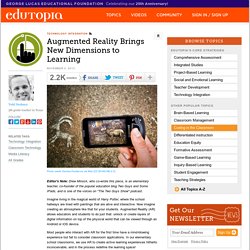
Imagine living in the magical world of Harry Potter, where the school hallways are lined with paintings that are alive and interactive. Now imagine creating an atmosphere like that for your students. Augmented Reality (AR) allows educators and students to do just that: unlock or create layers of digital information on top of the physical world that can be viewed through an Android or iOS device. Most people who interact with AR for the first time have a mind-blowing experience but fail to consider classroom applications. In our elementary school classrooms, we use AR to create active learning experiences hitherto inconceivable, and in the process redefine the learning space!
Classroom Applications Not Just Another Fad There are endless ideas and possibilities for using AR. Junaio Augmented Reality Browser. I-nigma QR Code, Data Matrix and 1D barcode reader. Alternate Reality Games in the Classroom – ProfHacker - Blogs. A few years ago I attended my first conference with an alternate reality game implemented as a way of engaging participants as a learning community, and ever since I’ve been hooked.
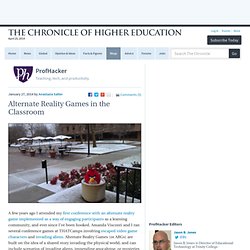
Amanda Visconti and I ran several conference games at THATCamps involving escaped video game characters and invading aliens. Alternate Reality Games (or ARGs) are built on the idea of a shared story invading the physical world, and can include scenarios of invading aliens, impending apocalypse, or mysteries waiting to be solved. While some incorporate technology or social media, many ARGs are built by transforming objects and spaces in the learners’ physical environment. Players collaborate and react to those ongoing stories through the mediation of the game designer, and in so doing, build new skills towards the intended learning objectives.
It can be hard to get a clear picture of ARGs without participating in one directly. Step One: Planning the Educational / Training Objectives [Photo by author] Aurasma. Tons of Classroom Examples Using Augmented Reality with @Aurasma - A Complete How-To Guide! How to Use Augmented Reality in Your Classroomthis post is read best via a desktop due to the embedded video content Augmented reality allows someone to add another layer to an existing image.
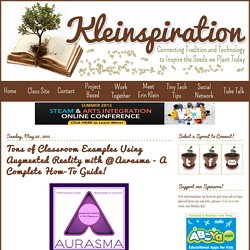
For example, imagine holding your phone over a poster on the wall as if you were going to take a photo of that poster, and then instantly a video starts playing to offer you additional information about that particular poster. Pretty cool, right? The first time it happens, it seems like magic. After watching the video below, I knew I had to figure this augmented reality thing out.